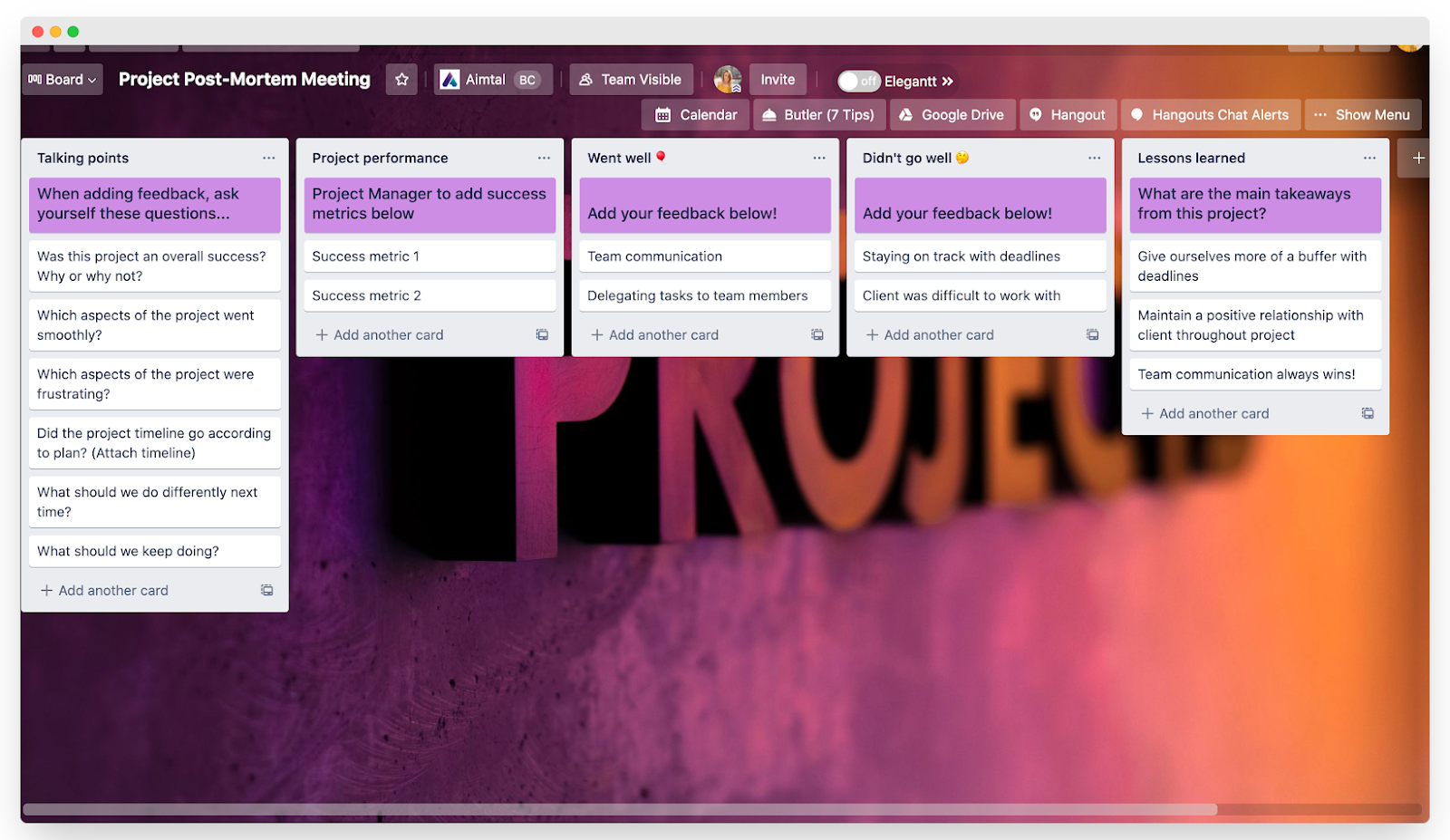The end of a project often feels like the end of an era. From the early project planning stages to the very last team meeting—it’s a journey of highs, lows, and lessons learned along the way. The completion of a lengthy project comes with sighs of relief and a sense of accomplishment. But before you pop the confetti, there’s more work to be done before you call that project ‘complete’.
Hold the eye rolls and hear this one out!

Many teams mistake the last step of a project as the go-live date or when all of the subtasks have been completed. However, many teams forget that the true final step of a project is coming together as a team to reflect on the successes and failures of the project and document these findings to improve things for next time.
This final event in a project timeline has a fancy term: the post-mortem meeting (also known as a debrief, reflection, or retrospective)—and including one in your project plan is well worth your team’s while.
What Is A Post-Mortem Meeting?
So what exactly does this mysterious meeting entail? The concept of a post-mortem meeting is simple: it’s held at the end of a project and its goal is to look at the project as a whole and determine what went as planned and what can be improved.
By the end of the meeting, your team should have identified best practices and opportunities for improvement going forward.
Why Should My Team Run A Post-Mortem Meeting?
While a post-mortem team meeting does add yet another meeting to your calendar–it’s one you shouldn’t put off or nix altogether. Post-mortem meetings are a legitimate part of the project’s life-cycle, and skipping over them could mean missing out on some big payoffs for what is usually a very small investment of your team’s time.
According to Backlog, an effective post-mortem meeting can help your team:
- Increase efficiency: Reviewing process and planning post-project will help to identify areas for improvement and find a better way to approach tasks next time.
- Improve communication: By providing a designated time to talk and listen to each other, post-mortem meetings help bring teams closer together and improve everyone’s awareness of what everyone else is up to.
- Learn from mistakes: Reviewing project woes and wins will help work out what went wrong and what went right.
- Get closure: Holding a meeting is a collaborative way to officially end a project and give everyone a final chance to have a final say, and celebrate its completion!
- Share and document information: Sharing the meeting outcome with the rest of the team or organization helps everyone else understand the value of the project and the main sentiment of its success (or lack thereof). Then, document the analysis and notes in your team’s shared knowledge space.
Using Confluence And Trello To Manage Post-Mortem Meetings
As with everything with working teams, good organization is the key to success. So when it comes to hosting a productive post-mortem meeting, approach it the same way you would any other important meeting: prepare, stay focused, and follow-up with documentation.
This poses the question—what tool should your team use to run a post-mortem meeting and document its findings afterward? Teams around the world have cracked this code, and the solution involves two tools who work so well together, you might call it a match made in heaven. Who said romance was dead?
Trello has been long used by teams to organize meetings of all kinds, post-mortem included. While Confluence, another Atlassian product, is great for housing collaboration efforts and storing knowledge and resources. With these two tools, you can easily gather and organize information gained from a post-mortem meeting and then store it permanently for later reference.
Funny enough, the word ‘confluence’ is defined by the junction of two rivers—and we’re about to explore how Trello and Confluence can be combined into one workflow for a smooth-flowing project post-mortem process.
1. Prepare For Your Post-Mortem Meeting In Trello
To help your team get in the right headspace for analyzing the project, it’s a good idea to give them access to a digital space where they can start brainstorming a few days before the meeting.
To do this, set up a Trello board with the following lists:
- Talking points: Questions for brainstorming
- Project performance: Add success metrics and analytics here
- Went well: For positive pieces of feedback
- Didn’t go well: For aspects of the project the team wishes to change in the future
- Lessons learned: The main takeaways from the conversation
Within the talking points list, you should add cards to help get the brainstorming wheels turning for your team.
Include questions like:
Was this project a success? Why or why not?
Which aspects of the project went smoothly?
Which aspects of the project were frustrating?
⌚ Did the project timeline go according to the plan?
What should we do differently next time?
What should we keep doing?
Instruct the head of the project to add success metrics under the ‘Project Performance’ list. These metrics will differ based on the type of project but should provide some concrete data about whether or not your team met the original project goals. These will be helpful to refer to during the meeting.
Before the meeting, have your team add their feedback to the ‘Went well’ and ‘Didn’t go well’ lists, with each piece of feedback being its own card. These lists can be added to during the meeting as the conversation progresses.

Use Card Covers to add visual cues to your board. To do this, simply open a card, select ‘Cover’, choose a color, a photo from Unsplash, or upload your own image, and then decide if you’d like it to apply to the entire card or just half of it.

Instead of having team members add multiple cards with the same sentiment or feedback, enable the Voting Power-Up and if there’s a card with feedback that multiple team members agree with, have them vote for it. This feature makes it easy to tell at-a-glance which pieces of feedback the majority of the team agrees with or doesn’t agree with.
To cast a vote, simply hover your mouse over a card and press ‘V’ on your keyboard—and a thumbs up should appear. The number of people who voted for a card will display on the card front.

2. Host And Organize Your Project Post-Mortem Meeting In Trello
Since many teams are remote these days, it’s helpful to have everyone on the team join the meeting via video if you’re not gathered in person. Having facial expressions visible will help to reduce any awkwardness and keep everyone engaged.
There are two key roles to assign for the meeting: a moderator and someone to take notes. The moderator is usually the Project Manager or another related manager and keeps an eye on the time, talking points, and directs the conversation in a productive way. The note-taker should be someone who is uber-organized—and being a fast typer doesn’t hurt, either!
To kick-off the meeting, everyone should give a high-level overview of how the project went as a whole. This will establish a consensus (or, maybe differing views!) of how the project went and will immediately highlight some talking points.
The next step should be reviewing the analytics listed under the ‘Project Performance’ list and making sure everyone understands the metrics. Then, it’s time to dive into the ‘Went well’ and ‘Didn’t go well’ lists.
This is the portion of the meeting that should take up the most time, so encourage all team members to participate. Remind them that their opinions and feedback will never negatively impact their status at the company—establishing psychological safety will keep the conversation honest and flowing.
The conversation should help your team determine which aspects of the project they’ll take with them going forward and which to ditch completely. Once these have been decided, add them to the ‘Lessons learned’ list, and review the main takeaways from the conversation.
No matter the outcome, be sure to celebrate the closure of another project and the opportunity to improve processes going forward, together.
3. Document Project Takeaways In Confluence
Next, it’s time to take all of these wonderful insights and store them in a place for your team and other departments to view, reflect on, and refer to in advance of the next project. Plus, if you created a Trello board specifically for a project that has since come to a close, you may want to archive the board while still keeping a record of what you learned along the way—that’s where Confluence steps in.
To store information and keep it organized, create a new child page in Confluence within your project’s page and name it something like “Post-Mortem Meeting”. You can also make it easier by using a Meeting Notes template. From here, you can start importing the main takeaways from your post-mortem meeting into a more permanent place.

If you’d like to directly link a Trello board or Trello card into the page you’ve created for your post-mortem meeting, simply copy the URL and paste it into the Confluence space, and a Trello-preview will display.
Just as in Trello, you can tag your team members, add labels, attach files, and organize the space however you please.


New to Confluence? The Confluence Cloud Power-Up for Trello makes this process a breeze. This feature helps provide the detail behind your work on a Trello card and the permanency to revisit what happened after the project is done.
Confluence pages support real-time comments and you can easily check the back of your Trello card to see how active your Confluence page is. You can also create Confluence pages from your Trello cards so your projects always have all the information needed, easily available from your Trello board.
Powerful Tools For A More Productive Project Post-Mortem
The next time your team completes the impossible… er, project—be sure to conduct a project post-mortem meeting to get the most out of your efforts and improve them for the future. When you tag-team this process with Trello and Confluence, not only will you be able to conduct the meeting with ease, but you’ll also be able to gain the insights you’re looking for and store them publicly for future use. Badda-bing-badda-boom.
So without further ado, pop those corks—as a now post-mortem meeting expert, you can now officially mark your project as completed.
Good or bad, we’d love to hear your thoughts. Find us on Twitter (@trello)!
Next: It’s Time To Set Better Boundaries With Your Screen Time
